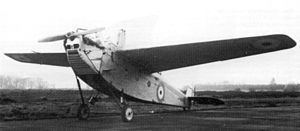Top speed 187 km/h Length 13 m Manufacturer de Havilland | Wingspan 16 m First flight 1921 | |
 | ||
The de Havilland DH.29 Doncaster was a British long-range monoplane of the 1920s built by de Havilland.
Contents
History
The DH.29 Doncaster was ordered by the British Air Ministry as an experimental long-range monoplane. The aircraft was a high-wing cantilever monoplane with unswept wings of wooden structure with a fabric covering. It had a box section wooden fuselage with a single fin. The crew of two were in an open cockpit ahead of the wing. Two aircraft were built between 1920 and 1921 at Stag Lane Aerodrome. Early testing of the first aircraft (Serial J6849) resulted in a redesign of the engine installation. The second aircraft (Registered G-EAYO) was built as a ten-seat commercial aircraft. The airlines were not interested in an untried monoplane and further development was abandoned, effort being put into the de Havilland DH.34 with a biplane configuration. A proposed military reconnaissance version, the DH.30, was never built.
The two aircraft finished their life at RAF Martlesham Heath with tests and trials, particularly on the thick-section cantilever wings. The Doncaster was the first British aircraft to use thick-section cantilever wings.
Operators
Specifications (military version)
General characteristics
Performance
